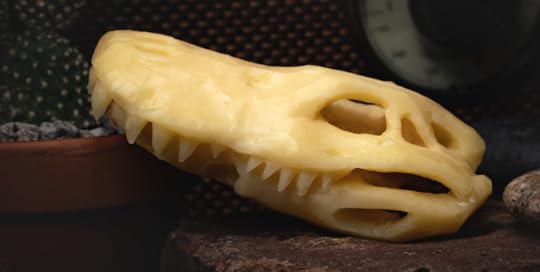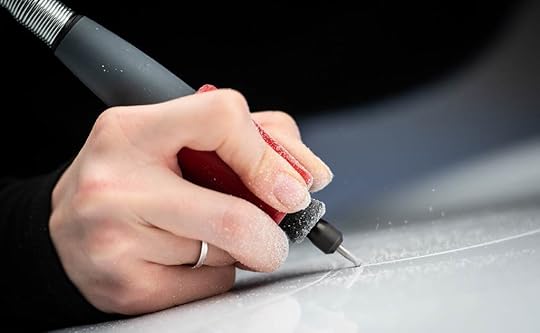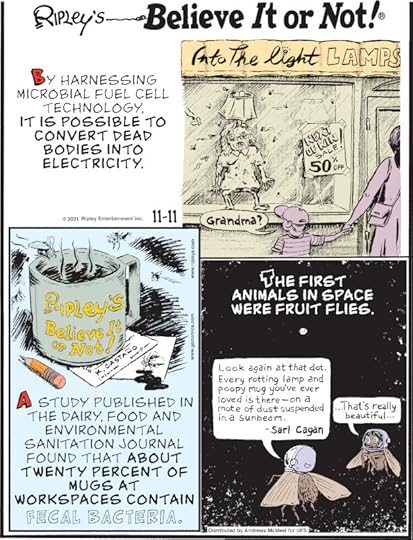Ripley Entertainment Inc.'s Blog, page 117
November 13, 2021
CARTOON 11-13-2021
November 12, 2021
Cuttin’ The Cheese: Deliciously Detailed Sculptures
Featured in Ripley's Believe It or Not!

Cheese lovers rejoice! Astoria, New York, resident Matthew Van Vorst picked up a new hobby during the COVID-19 lockdown — a unique one at that. He’s devoted many hours to sculpting and shaping the beloved foodie favorite: cheese. Featured in the latest Ripley’s book, Out of the Box, his “Cuttin’ the Cheese” project was actually Matthew’s first venture into sculpting. Who would’ve thought?
A Gouda IdeaIt all began with a couch-shaped block of cheese (that his co-quarantiners got a good chuckle out of), which quickly became a series of very detailed sculptures posted to an Instagram account devoted to the project. He’s made just about everything you could imagine, from feet to the Empire State Building and everything in between.

Gator Skull in Madrigal Cheese.
Brie-lieve It or Not!, the only material used in the process, aside from the tools, is cheese. No glue or anything to hold the sculptures together. Some varieties of cheese are better than others, Matthew says. He claims cheddar is the best for gouging and carving designs into, Swiss and Jarlsberg hold together well (and are perfect for hole-y structures), and Parmigiano-Reggiano is a cheese of all trades. It scrapes, cuts, and slices really well, which allows for the fine details to shine. Plus, it also is very sturdy and obviously the most delicious — at least in Matthew’s opinion!
We asked the artist what his most difficult cheesy venture was. He told us that his project titled Feet Slippers in Sharp Cheddar was the hardest, but also his favorite piece of work. The inspiration behind the idea was from an art piece by Emily Blythe Jones, which happened to be a pair of latex feet slippers. Matthew said it wasn’t easy to cut and shape like some of the more angular pieces. This was a part of the human body. It involved movement, life, and variation that had to be depicted effectively, which he accomplished. Matthew calls it “deliciously weird”.

Feet Slippers In Cheddar.
Grate Tips From the MasterMatthew’s refrigerator is undoubtedly always stocked with a variety of cheeses. He says that’s one of his biggest tips for any aspiring cheese artists out there: keep it cool. It gets more strenuous as the cheese warms up. It’ll sweat, get soft, and fall apart as it warms up while you’re trying to construct the sculpture. Take time to refrigerate and ensure there is good air conditioning at your place of work to avoid any melty mishaps.
Once the hard work is complete (and photos are taken), Matthew gives you the go-ahead to take a bite! He let us know that once his sculptures are done, they get eaten. Pass the cheese, please.
Take Your Own Step Out of the Box!Challenge yourself to get a little weird, try new things, and step out of your comfort zone with inspiration from Ripley’s Believe It or Not! Out of the Box, available now on Amazon and at most major retailers.
By Sam McCormack, contributor for Ripleys.com
STEP OUTSIDE OF YOUR COMFORT ZONE Experience the stories of adventurers near and far, from a three-year-old mountain climber to hair-hangers and acrobats. Leave inspired by unbelievable talents, breathtaking bucket list-worthy locations, and curious discoveries, all from people just like you as you uncover the pages of Ripley’s newest annual book!Traveling Trash Can Makes Its Way From Myrtle to Mayo
Featured in Ripley's Believe It or Not!

Beachcomber Keith McGreal, 44, and his children were taking a stroll along Ireland’s Mulranny Beach in County Mayo when they noticed a bright blue barrel had rolled in with the tide.
The romantic notion of a message in a bottle immediately came to mind, but the only love letter this vessel held was a sticker informing trash tossers that the bin was meant for recycling only — and that it belonged to the “City of Myrtle Beach, South Carolina.”
Before noticing the dirty sticker proclaiming the barrel’s ownership, McGreal noticed several context clues that it did not hail from the Emerald Isle, including a Spanish translation of its messaging and a thick coat of goose barnacles grown during the 3,500-mile journey.
Rolling with the message-in-a-bottle theme, McGreal set out to return the message to the city of Myrtle Beach with an email informing them of the tub’s travels.
Myrtle Beach public information officer Mark Kruea shared the email online Monday, explaining that after taking a close look and showing the photos to the city’s parks team, they can confirm that it is, in fact, their trash can.
Riding the Current to County MayoExactly how the recycling bin wound up in international waters remains unconfirmed. While Kruea speculated that either storm winds or “human intervention” could be responsible, oceanographer Chris Paternostro of the National Oceanic and Atmospheric Administration deducted that the Gulf Stream may have carried the barrel up the Eastern Seaboard before shuttling it across the Atlantic and onto the west coast of Ireland.
Regardless of the barrel’s mode of transport, Kruea said the event is “in the top 10 things” in his more than 20-year-long list of oddities — a list we’re going to need to see ASAP.
Marine Debris Under the SeaA storm may have swept up the garbage can, but literal tons of marine debris swim side-by-side with sharks, whales, and sea lions at any given moment, often after jumping ship during overseas transport.
From 61,280 pairs of Nikes splashing into the Pacific in 1990 to 28,800 rubber duckies taking the plunge in ’92, there’s no shortage of out-of-place items to be dispersed along international shorelines.
A coastal community in France spent 35 years baffled by a stream of Garfield phones rolling in with their tides before finally solving the mystery in 2019.
Embed from Getty Imageswindow.gie=window.gie||function(c){(gie.q=gie.q||[]).push(c)};gie(function(){gie.widgets.load({id:'hl2unN92SUp0nKlw49Ycfg',sig:'1tas-xpFwjDUf9p3FsQUmqMIkIIx46Pp7hqrrXMP-B0=',w:'594px',h:'394px',items:'1133770435',caption: false ,tld:'com',is360: false })});
More morbidly, dozens of sneaker-clad human feet have been discovered on the shores of the Pacific Northwest and British Columbia in recent years, washing up thanks to buoyant materials used in modern sneaker production.
Oceanographers sometimes use such events to study currents and tides since they often know exactly where the objects fell into the ocean and where they ended up. In the case of the Myrtle Beach trash can, this does not apply.
The Little Trash Can That Could“One trash can with an unknown time in the water and only a known origin is a little bit harder to give us a physical oceanography understanding,” said Paternostro.
The trash can may not make waves amongst the scientific community, but the irony of a recycling bin traveling through the very ocean it’s meant to protect could serve as a quirky educational tale for conservation efforts.
McGreal ensured the trash can’s journey was not for naught by cleaning it up and putting it to use on Mulranny Beach.
Make A Difference, Myrtle!Just a few miles from the South Carolina coast, our team at Ripley’s Aquarium of Myrtle Beach continues to research, learn, educate, and conserve our world’s waters. Through guest awareness, community initiatives, and sea animal rescue, the team has learned quite a bit about the importance of coastline care in Myrtle Beach.
Whether you’re a permanent resident or just visiting with family, there are plenty of things you can do to help in your own way! Recycling and reusing plastics decreases the amount of debris on beaches or in oceans worldwide. Beach and river cleanups, like those sponsored by Ripley’s Aquariums, are a great way to get involved in your local community and help eliminate unwanted trash from entering into our river systems and oceans.
Ripley’s Aquarium’s Assistant Director of Husbandry, Stacia White, encourages you to do your part no matter where you’re visiting from or headed to. “Just by picking up discarded trash along our beaches and waterways, you are playing an important part in helping to protect our marine environments.”
By Meghan Yani, contributor for Ripleys.com
EXPLORE THE ODD IN PERSON! Discover hundreds of strange and unusual artifacts and get hands-on with unbelievable interactives when you visit a Ripley’s Odditorium!Source: Traveling Trash Can Makes Its Way From Myrtle to Mayo
CARTOON 11-12-2021
November 11, 2021
The Hamster That Trades Cryptocurrencies… And Profits
Featured in Ripley's Believe It or Not!

From Bitcoin to Ripple, Dogecoin to Ethereum, understanding the ins and outs of cryptocurrencies (and how to profit from them) isn’t for the faint of heart. After all, cryptos have a reputation for incredible volatility. Tens of thousands can be made and lost in a matter of days or even hours. Yet, the promise of getting rich quick continues to draw people to alternative money, and there are plenty of gurus out there who claim to have all the answers, including a hamster named Mr. Goxx.
Yep, you read that right, and don’t let the adorable appearance, furry body, and whiskers fool you. This little rodent is making it rain. Here’s the lowdown on the crypto-crazed critter, and how he got started in alternative coin investing.
The Livestreamed HamsterThe German hamster trades cryptocurrencies in a rigged container known as the “Goxx Box” and has done so since June 2021. The box contains two tunnels. Based on the hamster’s choice of tunnels, specific cryptocurrencies get bought and sold. While all of this might sound haphazard and random, Mr. Goxx is getting results. As of November 10, 2021, he boasts a portfolio with a time-weighted rate of return (TWR) of 28.42 %, according to Mr. Goxx’s Twitter feed.
Mr. Goxx gets livestreamed every day, and he often performs better than the S&P 500 over the same time span! Think of the iconic hamster’s “Goxx Box” as a cryptocurrency trading office. The hamster starts by selecting one of 30 different coins. Once Mr. Goxx has made his selection, he must decide between two tunnels. One tunnel triggers the “Goxx Box” to buy more coins, and the other tells Mr. Goxx’s owner to sell the chosen token.
The Trading Secrets of a RodentWhat are some of the top cryptocurrencies owned by the hamster? They include Ripple, Tron, and Ether. His portfolio contains $390 worth of Euros, and his owner buys and sells in $20 increments. What plans does Mr. Goxx’s owner have for the future? He’s exploring ways to give the hamster greater control over his choices. This will include allowing Mr. Goxx to choose buying amounts as interest in his livestreams (and subsequent revenues) increases.
In September 2021, Mr. Goxx’s portfolio reached an all-time high of $580. That represented nearly a 50 percent rise in profits in just three months. That said, more recent events, including a crypto sell-off, have revealed chinks in the fuzzy financial expert’s armor. That said, the hamster’s owner says Mr. Goxx still recognizes that a profit is a profit. The tiny rodent’s caretaker reports, “Mr. Goxx is happy to see that some of his investments finally pay off.” Considering the hamster’s performance has outstripped both the S&P 500 and Warren Buffet, we think the fuzzball may be onto something.
By Engrid Barnett, contributor for Ripleys.com
EXPLORE THE ODD IN PERSON! Discover hundreds of strange and unusual artifacts and get hands-on with unbelievable interactives when you visit a Ripley’s Odditorium!Source: The Hamster That Trades Cryptocurrencies… And Profits
CARTOON 11-11-2021
November 10, 2021
CARTOON 11-10-2021
November 9, 2021
World’s First Tattooed Car Pays Tribute To Traditional Japanese Artistry
Featured in Ripley's Believe It or Not!

An estimated 30 percent of Americans have tattoos, but did you know cars can get tattoos too? At least one particular vehicle can claim to have its own, unique ink. In 2020, Japanese automaker Lexus decided to pay tribute to its country’s traditional artistry and craftsmanship by commissioning the world’s first tattooed car, featured in Ripley’s latest annual book, Out of the Box.
London-based tattoo artist Claudia De Sabe from Red Point Tattoo was picked to create a koi motif on the UX compact SUV, according to the Lexus Europe Newsroom. In Japanese culture, koi represent good fortune and perseverance.
View this post on Instagram
A post shared by Ripley’s Believe It or Not! (@ripleysbelieveitornot)
Instead of a tattoo needle, De Sabe used a Dremel drill tool on the white vehicle, stretching her design across the whole SUV. First, she drilled off the surface paint, revealing the metal underneath, and then she drew her design on the vehicle. Next, De Sabe, who has 15 years of tattoo experience, used five liters of car paint followed by gold leaf detailing for a 3D effect. Afterward, the Lexus UX was treated to a protective coating of lacquer to preserve the “tattoo” and make it road-worthy.
The project took six months from concept to completion, while the actual “tattooing” took place over five 8-hour days. As expected, it was labor-intensive and very different from tattooing a human body. “When you work on skin there is a softness to it,” De Sabe noted in a video about the project. “[It’s] completely different when you’re working with a Dremel onto the car body. It is just metal on metal.”

De Sabe was inspired by the beautiful artwork she has experienced in Japan, such as temples and ukiyo-e prints. She copied the natural flow of a koi swimming and wrapped the tail around the roof of the Lexus UX. The hardest part was making sure the koi would fit with the design of the car.
Another challenge was that the engraving had to be perfectly precise because small mistakes couldn’t be covered or colored into the pattern as easily as it could be into human skin. The amount of time and effort put into the project produced a vehicle tattoo with an estimated value of £120,000 ($165,000 USD).

Japan’s relationship with tattoos has evolved over the years, which makes this project even more interesting. In as early as A.D. 720, tattoos were used as punishment, and criminals were tattooed on their foreheads to mark their bad deeds, according to Tsunagu Japan. Tattoos were outlawed in the 19th century and were later almost entirely associated with the Yakuza organized crime syndicate. Today, tattoos are becoming more acceptable in Japanese society; however, they are still banned in some private and public spaces, such as certain onsen baths.
It’s unclear whether tattooed cars will become more prevalent, but the practice is cost-prohibitive for a lot of drivers, so it’s unlikely to become a trend anytime soon.
Take Your Own Step Out of the Box!Challenge yourself to get a little weird, try new things, and step out of your comfort zone with inspiration from Ripley’s Believe It or Not! Out of the Box, available now on Amazon and at most major retailers.
By Noelle Talmon, contributor for Ripleys.com
STEP OUTSIDE OF YOUR COMFORT ZONE Experience the stories of adventurers near and far, from a three-year-old mountain climber to hair-hangers and acrobats. Leave inspired by unbelievable talents, breathtaking bucket list-worthy locations, and curious discoveries, all from people just like you as you uncover the pages of Ripley’s newest annual book!Source: World’s First Tattooed Car Pays Tribute To Traditional Japanese Artistry
1,000-Year-Old Remains Uncovered In Peru, Including Child Sacrifices
Featured in Ripley's Believe It or Not!

The Wari civilization flourished between A.D. 450 and 1000 in the coastal and highland regions of Peru. Controlling a large swathe of geographically diverse terrain, they exploited these locations to their advantage, engineering an empire via an extensive network of roads that connected powerful provincial capitals. The culture’s influence would endure well past its political height of power, influencing the later Inca civilization.
Archaeologists have long recognized the Wari as a militaristic people. Researchers have also focused on how the Wari employed agriculture and innovative irrigation systems to create economic prosperity and stability. But recent discoveries reveal another aspect of Wari culture, one bathed in the blood of animal and human sacrifices.
Here’s what you need to know about the find that’s rewriting what we know about this ancient Peruvian culture.
Deconstructing a Grisly PastAt Huaca Santa Rosa de Pucalá, located in the Lambayeque region of northwestern Peru’s Andean foothills, a gruesome and unprecedented picture of ancient Wari culture emerges. There, 29 human bodies interred roughly 1,000 years ago or more have been uncovered. Four of the skeletons have telltale indications of ritual sacrifice. They include one teenager and three children.
Besides human remains, the site also contains animal sacrifices, including llamas, alpacas, and guinea pigs. Interspersed are artifacts, including a knife with a half-moon-shaped blade and uncovered pots. Researchers identified the tombs as Wari because of the D-shaped enclosures typical of religious spaces in that culture.
A Vital Ceremonial SiteArchaeologists theorize the human sacrifices may have taken place during the consecration process before new construction began. After all, Huaca Santa Rosa de Pucalá contained an essential ceremonial complex with a history of use by diverse cultures. Besides the Wari, these included the Cupisnique and the Mochica, and evidence shows activity at the site dates to the Formative Period (900–200 B.C.). Only the burials of the sacrificed youths come from the Wari period.
What about the rest of the skeletons found at the site? They belong to individuals from the Mochica culture, active in the Lambayeque region between A.D. 100 and 700. The remains identified as Mochica sit in burial chambers in clay tombs within the temple.
Rewriting History One Find at a TimeBesides the presence of human sacrifices, this archaeological site is rewriting history in other ways. For one, the Wari civilization was centered in the Andes of Ayacucho, far removed from Lambayeque. So, their presence at this temple demonstrates the culture had a much further reach than archaeologists previously hypothesized.
According to Edgar Bracamonte Lévano, lead researcher at the excavation, “These discoveries allow us to rethink the history of the Lambayeque region, especially the links to Wari and Mochica occupations in the area.” No doubt, as researchers more closely study these finds and the evidence associated with each artifact, a more complicated picture of the Wari will emerge. One of a sophisticated society with a truly sinister side.
By Engrid Barnett, contributor for Ripleys.com
EXPLORE THE ODD IN PERSON! Discover hundreds of strange and unusual artifacts and get hands-on with unbelievable interactives when you visit a Ripley’s Odditorium!Source: 1,000-Year-Old Remains Uncovered In Peru, Including Child Sacrifices
CARTOON 11-09-2021
Ripley Entertainment Inc.'s Blog
- Ripley Entertainment Inc.'s profile
- 52 followers








